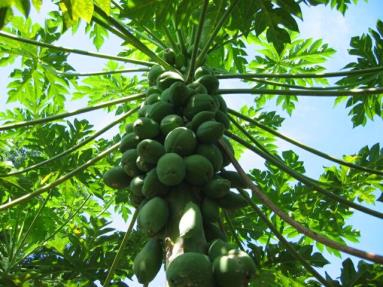
Know Our Herbs

Papaw Tree
English Name:- Papaw Tree
Botanical Name:- Carica papaya
Family:- CARICACEAE.
Parts- Used:- Leaves, Fruits and seeds.
Habit:- A small tree, deciduous with milky juice, 5-7 meter high; with hollow stem and unisexual flowers.
Taste:- Sweet
Chemical Constituents:- Latex of unripe Fruit Contains: Papain, Proteolytic enzyme, Chymopapin, Pectin, Mallic acid; Fruit Contains: Protein, Sugars, Ceyptoxanthin, Violaxanthin, Zeaxanthin, Beta-carotene, Ascorbic acid, Thiamine, Riboflavin and other Vitamins, Carpasemine Ripen Fruits Contain Two-Three thous and intern ational units of Carotene from which Vitamin A is formed.
Actions:- Appitizer, Digestive, Laxative, Stomachic, Carminative, Diuretic.
Used In:- Fruit: Haemorrhagic disease, Piles; Latex useful in Spleenomegaly; Milky Latex of Green Fruit: Anthelmintic, used in Liver enlargement, Ringworm, Diarrhoea, Seeds: Anthelmintic and used in: Emmenagogue; Juice of leaves useful in Cardiac disease.
- It improves digestion because of the presence of Chymopapin and Papain compounds.
- It kills intestinal worms and removes other intestinal problems.
- It is beneficial in the treatment of skin diseases like eczema, cutaneous, tubercles.
- The sinapisms prepared from its root are beneficial in the treatment of uterus tumors.
- The latex of the plant is smeared at the mouth of the uterus and the root infusion is used for syphilis.
- It is highly antiseptic and beneficial in curing psoriasis.
- Its leaves are used for treating nervous pain and elephantoid growths.
- The infusion of its root reduces urine concretions.
- It reduces urine acidity in human. Its flowers are used in treating jaundice.
- Its latex cures dyspepsia and burns. It is beneficial in arthritis also.
- It is beneficial in curing the enlarged spleen.
- A glass of papaya shake taken two times daily cures sleeplessness and brings sound sleep.
- It contains vitamin A, B, C, and D which are highly beneficial in removing diseases
- pertaining to eyes, urinary system, bones, blood pressure and paralysis.
- It cures acne pimples. Its latex is highly useful in cardiac problems.
Caution
Its latex can cause severe gastritis, conjunctivitis and vesication.Information on the traditional uses and properties of herbs provided on the site is for educational use only, and is not intended as medical advice. Every attempt has been made for accuracy but none is guaranteed. Many traditional uses and properties of this herb have not been validated by the FDA. If you have any serious health concern you should consult with your health care practitioner before self administering this herb.
